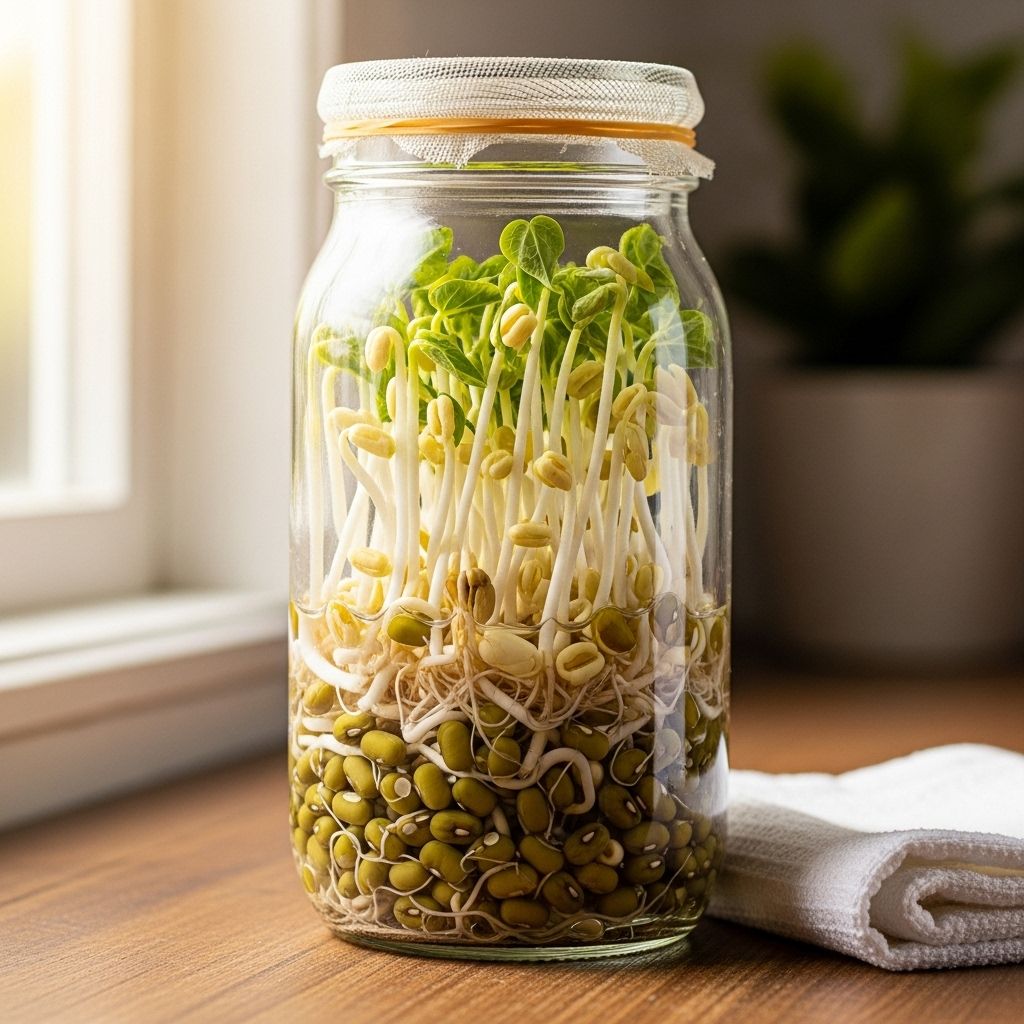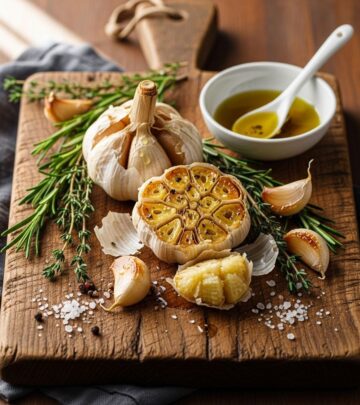How to Grow Bean Sprouts in a Jar: An Easy, Step-By-Step Guide
Turn a simple jar of beans into a crunchy superfood with minimal fuss.

How to Grow Bean Sprouts in a Jar
Bean sprouts are a versatile, nutritious, and refreshingly crisp addition to all kinds of dishes—from stir-fries and salads to sandwiches and soups. Growing them at home is surprisingly simple and inexpensive, requiring only basic supplies and a little daily attention. In this guide, you’ll learn exactly how to turn dried beans, especially mung beans, into a jar full of crunchy, juicy sprouts. The method is accessible for beginners, can be done year-round, and takes less than a week from start to finish.
Table of Contents
- Why Grow Your Own Bean Sprouts?
- What You’ll Need
- Step-by-Step Instructions
- Troubleshooting & Tips
- How to Use and Store Homemade Sprouts
- Frequently Asked Questions
Why Grow Your Own Bean Sprouts?
Sprouting your own beans at home offers several distinct advantages:
- Freshness: Homegrown sprouts are often crisper and more flavorful than store-bought.
- Nutrition: Bean sprouts are rich in vitamins (notably vitamin C and K), protein, and fiber. The sprouting process also boosts certain micronutrients and reduces some anti-nutrients found in raw beans.
- Cost: Growing sprouts at home is extremely economical. A small bag of dried mung beans can yield weeks worth of fresh sprouts for just a few dollars.
- Availability: Store-bought bean sprouts can be hard to find, may spoil quickly, and are often packed in plastic. Home sprouting avoids these issues and eliminates waste.
- Control: You know exactly how your sprouts were grown and can ensure cleanliness and organic methods.
What You’ll Need
Gather the following basic items before you get started. Most supplies are reusable for future sprouting projects.
| Item | Notes |
|---|---|
| Glass jar | Quart (32 oz) is ideal, wide-mouth jars are easiest to clean and handle. |
| Dried mung beans | Ensure they’re specifically labeled for sprouting or organic for food safety. |
| Mesh or cheesecloth | Fine enough to keep beans inside while draining. |
| Rubber band or ring | Secures cloth on jar mouth. |
| Bowl or dish | To prop the jar at a slant for drainage. |
| Water (filtered if possible) | For soaking and rinsing beans. |
Tip: You can also buy specialized sprouting jar lids with mesh screens, but simple cheesecloth plus a rubber band works perfectly well.
Step-By-Step Instructions
1. Measure and Rinse
Start with 2 tablespoons of dried mung beans. This may seem like a small amount, but the beans expand significantly and fill the jar when sprouted.
- Pick over the beans to remove any debris or damaged beans.
- Place them in your jar and cover with cool water. Swirl, then drain to rinse off dust or dirt. Repeat 2-3 times until water runs clear.
2. Soak
- Add several cups of cool water (at least 3-4 times the beans’ volume) to the jar to fully submerge the beans.
- Cover the jar mouth with cheesecloth or mesh screen, secured by a rubber band or ring.
- Let beans soak at room temperature for 8–12 hours (overnight recommended). The beans will swell and begin to split their skins.
3. Drain and Rinse
- After soaking, drain the water through the cheesecloth (or mesh lid). Rinse the beans gently with cool fresh water and drain completely again.
- Tip the jar upside down at a 45-degree angle inside a bowl or dish. This allows any excess water to escape while air continues to circulate around the beans.
4. Sprout and Care (Days 1–5)
The actual sprouting process now begins. Returning to the jar twice daily, you’ll help keep the beans moist and healthy.
- Twice per day (morning and night), fill the jar with cool water. Swirl beans gently, drain thoroughly, and replace the jar at a slant.
- Keep the jar in a dark, room-temperature location (inside a cupboard or covered with a towel) to encourage long, pale sprouts. Light can cause the sprouts to green and become bitter.
- Repeat: Rinse, drain, and rest at a slant every 12 hours for 3–5 days.
After 2–3 days, you’ll notice small white tails emerging. By day 4 or 5, sprouts should be plump, crunchy, and at least 1–1.5 inches long.
5. (Optional) Thicker Sprouts
- If you prefer extra-fat, crunchy sprouts (like those in restaurant stir-fries), you can weigh the beans down during sprouting. Place a small plate or jar lid directly on top of the beans in the jar, followed by a small weight (such as a full can or book). This creates plumper, toothsome sprouts.
6. Harvesting and Preparing Sprouts
- When sprouts are the desired length and thickness (usually 4–5 days in), give them a final rinse.
- To remove loose bean skins (hulls), transfer sprouts to a large bowl and cover with cool water. Gently stir: hulls will float and can be skimmed away. This is optional as the hulls are edible but can affect texture.
- Drain thoroughly in a colander or on paper towels.
Troubleshooting & Tips
- Beans don’t sprout? Ensure you’re using viable, fresh mung beans labeled for sprouting (older beans may not germinate). Organic or untreated beans work best.
- Smelly or slimy sprouts? This is a sign of excess moisture or poor drainage. Always drain thoroughly and avoid letting water pool at the jar’s bottom. Wash everything thoroughly between uses.
- Sprouts are bitter or green? Exposure to light causes green leaves and bitterness; keep the jar in the dark for pale, mild sprouts.
- Mold issues? Rinse thoroughly and ensure the beans aren’t too densely packed. If you see fuzzy growth or smell something off, discard the batch, sterilize the jar, and start over.
- Sprout length: Taste the sprouts at each rinse after day 3. Some people prefer stubbier sprouts (early) while others like them longer (up to day 5 or 6).
How to Use and Store Homemade Sprouts
Storing Bean Sprouts
- Once fully sprouted, dry the sprouts on a clean towel or in a colander for an hour to remove excess moisture.
- Transfer to an airtight container lined with a paper towel or cloth (to wick away moisture). Store in the refrigerator for up to 5 days.
- To keep sprouts crisp, rinse them lightly every day and drain before returning to the fridge.
Serving Suggestions
- Salads: Toss fresh sprouts into green salads for crunch and nutrition.
- Stir-fries & Asian dishes: The classic use—add to hot pans right before serving for maximum crispness.
- Sandwich fillings: Layer bean sprouts with other veggies for texture.
- Wraps, rolls, tacos: Sprouts add bite and juiciness.
- Soup topping: Add just before serving for a delicious garnish.
Food Safety Note: Always rinse homegrown sprouts well and avoid eating them if they develop off odors or are past their prime. Pregnant women, children, the elderly, or those with weakened immune systems should avoid raw sprouts, or cook them thoroughly before eating.
Frequently Asked Questions (FAQs)
Q: What kinds of beans can I sprout with this method?
A: While mung beans are the most popular and reliable for home sprouting, you can also sprout lentils, adzuki beans, and certain seeds like alfalfa or broccoli using a similar process. Always use seeds/beans sold specifically for sprouting to ensure food safety.
Q: Why do my sprouts sometimes turn brown or smell bad?
A: Off colors or odors typically mean excess moisture or insufficient rinsing. Discard any batch that does not look or smell right and sterilize your equipment before restarting with new beans.
Q: How long do homegrown bean sprouts last?
A: If stored properly in the fridge in a well-ventilated, lined container, sprouts usually last 3–5 days. Discard if they become slimy, soft, or develop an unpleasant smell.
Q: Is weighing the sprouts necessary?
A: No, but weighting (with a plate and light object) can produce thicker, juicier sprouts if you prefer the texture of restaurant-style mung bean sprouts.
Q: Can I use just any beans or seeds from the grocery store?
A: Do not use dried beans sold for cooking unless they’re specifically labeled as untreated and suitable for sprouting. Non-sprouting beans may have been treated or stored in conditions that prevent germination or are unsafe.
Quick Reference Table: Troubleshooting
| Problem | Likely Cause | Solution |
|---|---|---|
| Beans don’t sprout | Old/damaged beans, not for sprouting | Use fresh, organic sprouting beans |
| Sprouts smell bad | Stagnant water, poor drainage | Rinse and drain more thoroughly; clean jar |
| Mold appears | Too warm, lack of airflow | Rinse more often, ensure jar is not sealed airtight |
| Bitter taste | Too much light | Keep sprouting jar in dark space |
Final Thoughts
With this straightforward approach, you can enjoy plentiful batches of fresh bean sprouts throughout the year. The method is gentle on your schedule and wallet, and yields a wonderfully crisp, living food that enlivens any meal with minimal effort. Once you’ve mastered mung beans, experiment with other legumes and seeds for endless sprouting possibilities!
References
Read full bio of medha deb












